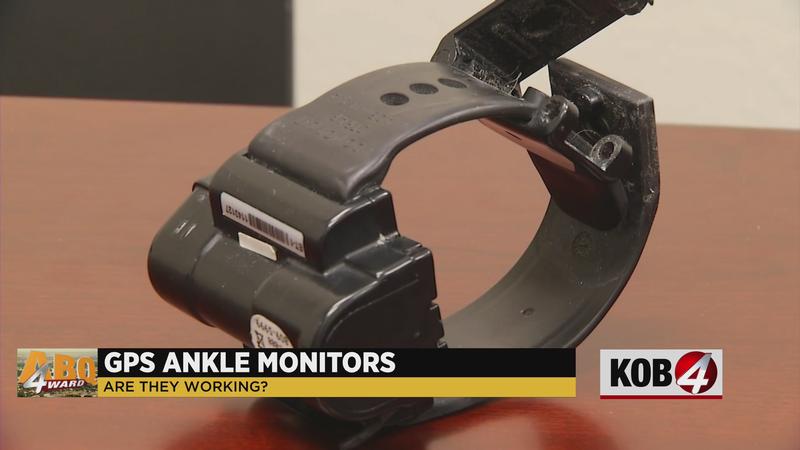ABQ 4WARD: Proof the court does not actively monitor GPS ankle monitors
[anvplayer video=”5051585″ station=”998127″]
ALBUQUERQUE, N.M. — By its own admission and through documents obtained by KOB 4, it is evident that the 2nd Judicial District Court does not actively monitor the whereabouts of the many people who are part of the court’s Pretrial Services Division who are ordered to wear a GPS ankle monitor by a judge. And the lack of supervision has been tragic.
Two glaring examples that highlight the problem include the cases of Devin Munford and Angello Charley. In December 2020, APD arrested Munford accusing him of shooting a gun while driving. Bernalillo County District Attorney Raúl Torrez asked a judge to keep Munford in jail pending a trial, but instead Judge Clara Moran released Munford to the Pretrial Services Division and ordered he wear a GPS ankle monitor.
Pretrial Services is a division of the court that is responsible for making sure defendants report back to court for hearings or a trial. Pretrial Services is also responsible for alerting the court, prosecutors and law enforcement if somebody steps out of their approved GPS zones. A judge may order someone to stay at home, or away from schools or victims. The judge draws exclusion zones and it’s up to Pretrial Services to monitor them and notify the right people if a defendant has left an approved zone.
But in Munford’s case, it appears nobody was notified when he stepped out of his zones.
“Mr. Munford was supposed to effectively be on house arrest,” District Attorney Torrez told KOB 4 in April. “The GPS monitoring system was supposed to be in place that kept him under close supervision. It appears to me that there was no active supervision by Pretrial Services.”

While wearing his GPS monitor one weekend in April, police believe Munford killed a man at an apartment complex and then robbed a convenience store at gunpoint the next night. According to Torrez, neither his office nor law enforcement were notified that Munford left his GPS boundaries.
Angello Charley has a similar story. Charley was also supposed to be supervised by Pretrial Services after a judge ordered he wear a GPS monitor stemming from allegations he raped a woman. But according to police, he used social media one night to leave his approved boundaries and meet up with a 15-year-old girl. According to court documents, he then tried to sexually assault that teenage girl.
“An alert should have been sent to a police officer,” Torrez said. “An alert should have been sent to the D.A.’s Office. An alert should have sent to someone in law enforcement so we don’t risk the health, life and safety of a 15-year-old girl in this community.”
An alert wasn’t sent because nobody at Pretrial Services is monitoring anybody’s GPS movements in real time on weekends, at night or on holidays.
The Proof
KOB 4 requested time cards from each employee who works at the Pretrial Services Division over several pay periods. The time cards reveal no employee worked on holidays, weekends or evenings. Surveillance video KOB 4 requested of the work space inside Pretrial Services during a few evenings also shows no one working.
Pretrial Services admits in its own documents, that it “passively monitors” GPS bracelets. In a document provided to KOB 4 by a spokesman for the court, it states, "Pretrial Services GPS monitoring is considered a passive monitoring, meaning Pretrial Services staff does not work in the field."
KOB 4 asked the spokesman to further clarify what exactly “passive monitoring” means.
In an email, spokesman Sidney Hill wrote:
"If an alert is generated because someone enters an exclusion zone, either during normal business hours or at night or on a weekend, Pretrial Services will file a report of the alleged violation with the judge and to both the prosecuting and defense attorneys within 24 hours of receiving notification of the alert. Pretrial services staff receive alerts that occur at night or on the weekends the following business day."
What that means is if a defendant left his GPS zone on a Friday evening, nobody would know about it until at least Monday morning.
“I can’t disagree that it is concerning if we go 12-24 hours before we review ankle monitoring,” said Artie Pepin, director of the New Mexico Administrative Office of Courts.
Pepin works directly for the New Mexico Supreme Court and he sees a big problem with waiting so long to know that a potentially dangerous person has left his GPS zone.
“The monitoring is in real time, it should be reviewed in real time,” Pepin said. “We are looking at this issue, but I share the concern, obviously that is a legitimate concern.”